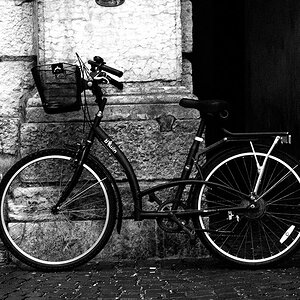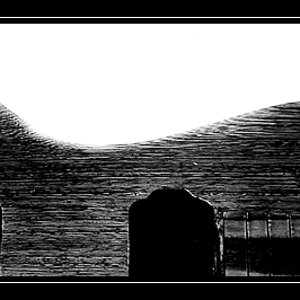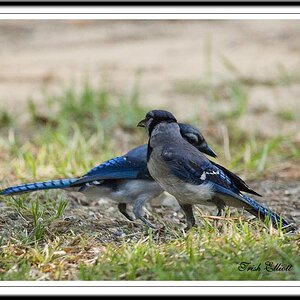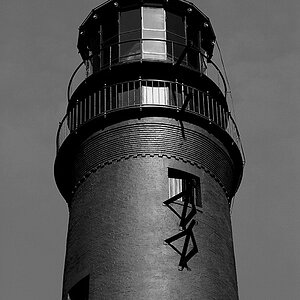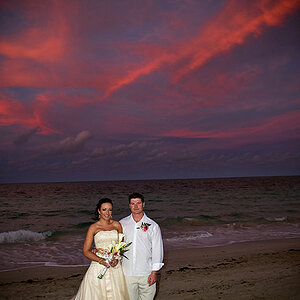- Joined
- Nov 19, 2010
- Messages
- 2,507
- Reaction score
- 440
- Location
- San Jose, CA
- Can others edit my Photos
- Photos OK to edit
I THINK I got it to work right... You have some serious calibration/color issues in that album. It's very blue. Otherwise it looks like you are getting the hang of things! It really does get easier!
Elaborate on this? I believe I had my WB set to Auto, shooting in Aperture Priority on a Nikon 80-200 f/2.8.
Is your monitor calibrated? How do those images look on your computer?
You are fine shooting in auto white balance especially if you are shooting in raw. Raw you can completely change the white balance in post.
Those either were tweaked to a very cool setting or the camera erred to the cool side-which is odd in this situation. It'd actually tend to err to the side of magenta because of all of the green in the grass... All of which leads me to think your monitor is not calibrated and you have tweaked to match what you see on your monitor. It will print BLUE. very blue.
I have not calibrated my monitor, do you have a resource on how to do this? I shot in Jpg, small size. If it were up to me, ALL my images would be processed, but my orders are to shoot approx. 1500 images per game (JV and Varsity, and then to (for now) hand off my SD card to my superior. Honestly, set aside experience in shooting sports, I understand my camera more than most of the other photographers, and with that being said, most images on that site aren't that much better than mine - again, set aside composition (I am still learning how to compose sports shots)
Elaborate on this? I believe I had my WB set to Auto, shooting in Aperture Priority on a Nikon 80-200 f/2.8.
Is your monitor calibrated? How do those images look on your computer?
You are fine shooting in auto white balance especially if you are shooting in raw. Raw you can completely change the white balance in post.
Those either were tweaked to a very cool setting or the camera erred to the cool side-which is odd in this situation. It'd actually tend to err to the side of magenta because of all of the green in the grass... All of which leads me to think your monitor is not calibrated and you have tweaked to match what you see on your monitor. It will print BLUE. very blue.
Calibrating the monitor isn't going to help shoot sports, that is the point here. tevo has a long way to go before worring about the monitor, or grey cards, or thirds, all of which really don't apply to shooting sports. It is a new area of photography, learning the basics of shooting sports is what matters.
Outdoors, iso around 200 in sunlight, 400-800 in overcast and 1000-1600 under dark skies. Shutter speeds no slower than 500th, aperture between 5.6-8.0. Indoors iso that works with the light avaliable, if it's 1600-3200 then that's what you have to figure on, not ideal, shutter speeds, 400th-500th, for action, you can get away with slower speeds and better iso if you shoot around the action, the static players. Aperture 2.8 if you have, if not work around it and shoot as fast as your lens is. Don't over think what you're trying to do. I won't go into shooting in the snow, a whole new set of concerns. It shouldn't take you more than a few minutes to figure out your camera settings for each venue, especially indoors, they don't change.
1000-1600 under dark skies? I get 80-100 shutter wide open at night @ that iso.. I try to keep my shutter around 500, and I generally keep my aperture wide open. IMO my pictures were lit decently, besides having a blue-ish tint to them. These will not get printed at any point, the company just uploads the pictures for players to look at.
I usually divide my football settings (for night time shooting) into zones. If the field has 4 light poles, I have a 50 yard line zone, a 30 yard line zone, and an endzone zone. I keep my aperture at f/2.8 and will set my ISO so I can shoot around 1/640 in the 30 yard line zone, and 1/500 in the other zones. Given the stadium lighting, I don't see these as too blue.
I've learned you need to be about 15 yards from the line and WAIT for the action to come your way. It's not even worth shooting anything that goes down the other sideline. And after I get my action shots that I want, I play around with shooting lineman, linebackers, etc.
For some reason, I get shunned by some DB's on this forum when I suggest it, but you really need a face in sports photography. Parents and newspaper editors don't run shots of backs. Typically (and I use it lightly), the needs to be in focus. Granted, shooting at night gives me LOTS of unfocused shots...I've learned to toss those out.
From your shots, I would suggest the following: tighter shots (including less headroom), tossing out the out-of-focus shots, and only include a distinct plays or scenes in your set (it might not be necessary to include 5 shots of the kickoff). It looks like you've got the settings down, you just need to refine!
Thats a good idea, do you just use the U1 and U2 (or canon version) modes? I try to keep faces when I can, and if it were up to me I would delete all the OOF shots before I upload.. unfortunately, I was told to just hand off my SD card after the game so my superior could upload it. I didn't have time to go through all my shots during the game.
I went though some of the gallery and understand that this is the first time you've really been shooting football, but what it looks like is that you are just pointing the camera and hoping that you end up with anything. What you have to do is isolate on players. I have to say that the way the photos are uploaded doesn't help, there shouldn't be any garbage going online. it's it's not sharp or just a bad images delete it in the camera. There is lots of time during a game to chimp, at half time, just go through and dump all the images you don't want online. If it means that you only end up with 50 strong images, that is better than 150 bad ones as well, bad brings the quality down and if people see enough of them they stop looking. I don't know if you're getting paid to shoot, or paid based on sales.
If you're interested in looking at some football I have over 4300 football images on my site, it should give you a better idea as to what works. www.imagecommunications.ca just visit any of the team galleries. The majority of them were shot on film Hope this helps.
I will take a look! And I have somewhat of a spray and pray method. I was told to shoot in Ch, and try to "capture the play" as much as possible. I dont think they are looking for artistic, well composed shots - moreso just to show what happened during the game. And yes, if it were up to me, none of the non-keepers would be online. I am getting paid per game. As far as I know, I am the only new recruit they have, and to my knowledge the other photographers are providing what the company wants. With that said, compare my images to some of the others and tell me what differences you see. I will be talking to the other photographers and getting C&C from them on composition.
Calibrating the monitor isn't going to help shoot sports, that is the point here. tevo has a long way to go before worring about the monitor, or grey cards, or thirds, all of which really don't apply to shooting sports. It is a new area of photography, learning the basics of shooting sports is what matters.
Outdoors, iso around 200 in sunlight, 400-800 in overcast and 1000-1600 under dark skies. Shutter speeds no slower than 500th, aperture between 5.6-8.0. Indoors iso that works with the light avaliable, if it's 1600-3200 then that's what you have to figure on, not ideal, shutter speeds, 400th-500th, for action, you can get away with slower speeds and better iso if you shoot around the action, the static players. Aperture 2.8 if you have, if not work around it and shoot as fast as your lens is. Don't over think what you're trying to do. I won't go into shooting in the snow, a whole new set of concerns. It shouldn't take you more than a few minutes to figure out your camera settings for each venue, especially indoors, they don't change.
You are correct in that the monitor calibration is not going to help in SHOOTING sports, but you certainly aren't going to sell any images if the color is incorrect and doesn't look good on them either. Tevo is jumping into this head first and learning on the fly, so it's ALL got to come together. In the end the calibration and white balance do matter.
I am not talking about using the grey card for setting white balance, but we discussed using it for setting exposure and determining your bump up in exposure, so... little different there.
Rule of thirds is nice, but you're right-it doesn't matter. It's the emotion and action that matters in sports.
I'd also like someone to explain to me (because I am of a different mind that could very well be WRONG...) why you would choose aperture priority for sports when you know you are already going to have to shoot wide open? This is my line of thought (and like I said... it could be really wrong) in many to most situations you already know you are going to have to shoot wide open-inside a gym or on the night fields-so your aperture isn't in question ever. Why would you choose to keep an eye on what the camera is deciding for shutter speed if you know your aperture is going to max out on you? In which case I would choose to go with shutter priority. The camera can't screw up to awfully bad if you are hitting the wide open spot on the aperture. It's a non point. Not running the risk of the shutter dropping through the gutter would be more important to me, personally.
I shoot sports in full manual. It's easier than a priority mode for me and here's my thoughts on that: I know I am going to be forced to shoot wide open in most situations. I know I need to have a shutter of 1/640 or faster depending on the sport. That's the 2 main elements of your exposure right there. I also know that if I am on the football field at night I am going to max out my ISO.
With a priority mode I had more nightmares in post processing. The meter may have hit something dark and chose settings based on that or vice-a-versa. I had to fix and tweak constantly in post. Now I keep an eye on where my meter hits when it's reading the grass or the gym floor. I know where I want those things to fall in the meter (grass is about +1 or +1/2 and a gym floor is about a +1.5 to +2 depending.) As long as I check my meter here and there in changing light (football) making sure it's reading where I want it to, I am fine to shoot. In a gym your lighting never changes. Once you get one perfect exposure you don't need to meter again at all. I found that if I hit the white jerseys in a game I had dark images to fix and if I hit the navy or dark jerseys I had way too bright images to fix. It took me longer in post. Now I know my exposure is the same across the board. I can apply one preset that covers all of the images, delete the crap and I am done.
Could I be doing this differently that would make it still easier yet on me?
Edit to add: I am a bit like you in that I know if I am under the lights and I have to be in the end zone I have to change my shutter and/or ISO to accomodate for the dark, lack of light there. It's so much habit, just like your different zones that I just click according to where I am and what I know I need-that came with a little experience...
I will keep this in mind. I haven't tried shutter priority, and Manual seemed to take too much time - but I guess it really doesn't take that much time. I have to shoot small size .jpgs, since I have 2 16GB cards, which only hold about 6000 shots (RAW would be much too large). Any tips on metering for sports (more specifically football)
Calibrating the monitor isn't going to help shoot sports, that is the point here. tevo has a long way to go before worring about the monitor, or grey cards, or thirds, all of which really don't apply to shooting sports. It is a new area of photography, learning the basics of shooting sports is what matters.
Outdoors, iso around 200 in sunlight, 400-800 in overcast and 1000-1600 under dark skies. Shutter speeds no slower than 500th, aperture between 5.6-8.0. Indoors iso that works with the light avaliable, if it's 1600-3200 then that's what you have to figure on, not ideal, shutter speeds, 400th-500th, for action, you can get away with slower speeds and better iso if you shoot around the action, the static players. Aperture 2.8 if you have, if not work around it and shoot as fast as your lens is. Don't over think what you're trying to do. I won't go into shooting in the snow, a whole new set of concerns. It shouldn't take you more than a few minutes to figure out your camera settings for each venue, especially indoors, they don't change.
You are correct in that the monitor calibration is not going to help in SHOOTING sports, but you certainly aren't going to sell any images if the color is incorrect and doesn't look good on them either. Tevo is jumping into this head first and learning on the fly, so it's ALL got to come together. In the end the calibration and white balance do matter.
I am not talking about using the grey card for setting white balance, but we discussed using it for setting exposure and determining your bump up in exposure, so... little different there.
Rule of thirds is nice, but you're right-it doesn't matter. It's the emotion and action that matters in sports.
I'd also like someone to explain to me (because I am of a different mind that could very well be WRONG...) why you would choose aperture priority for sports when you know you are already going to have to shoot wide open? This is my line of thought (and like I said... it could be really wrong) in many to most situations you already know you are going to have to shoot wide open-inside a gym or on the night fields-so your aperture isn't in question ever. Why would you choose to keep an eye on what the camera is deciding for shutter speed if you know your aperture is going to max out on you? In which case I would choose to go with shutter priority. The camera can't screw up to awfully bad if you are hitting the wide open spot on the aperture. It's a non point. Not running the risk of the shutter dropping through the gutter would be more important to me, personally.
I shoot sports in full manual. It's easier than a priority mode for me and here's my thoughts on that: I know I am going to be forced to shoot wide open in most situations. I know I need to have a shutter of 1/640 or faster depending on the sport. That's the 2 main elements of your exposure right there. I also know that if I am on the football field at night I am going to max out my ISO.
With a priority mode I had more nightmares in post processing. The meter may have hit something dark and chose settings based on that or vice-a-versa. I had to fix and tweak constantly in post. Now I keep an eye on where my meter hits when it's reading the grass or the gym floor. I know where I want those things to fall in the meter (grass is about +1 or +1/2 and a gym floor is about a +1.5 to +2 depending.) As long as I check my meter here and there in changing light (football) making sure it's reading where I want it to, I am fine to shoot. In a gym your lighting never changes. Once you get one perfect exposure you don't need to meter again at all. I found that if I hit the white jerseys in a game I had dark images to fix and if I hit the navy or dark jerseys I had way too bright images to fix. It took me longer in post. Now I know my exposure is the same across the board. I can apply one preset that covers all of the images, delete the crap and I am done.
Could I be doing this differently that would make it still easier yet on me?
Edit to add: I am a bit like you in that I know if I am under the lights and I have to be in the end zone I have to change my shutter and/or ISO to accomodate for the dark, lack of light there. It's so much habit, just like your different zones that I just click according to where I am and what I know I need-that came with a little experience...
I think in my post I gave a pretty good idea as too what the exposures will be based on light. Yes indoors, if you have a 2.8 lens to work with then that's what you can work with, I shoot some stuff at a slightly slower speed and at 3.2-3.5. Shooting outdoors using field lights I work within the brightest points on the field, end zones tend to be in near total dark.
From what I've seen of the work tevo has online, he is really a long way away from selling much, regardless of the colour. It's not a cheap shot at his work, he is learning on the fly, but personally I would not take on a photo assignment that I couldn't do well. He has to learn and that is good, but having people see all of the garbage that should have been deleted isn't going to do him any favours.
I agree - I wish that they would "censor" what gets uploaded - but it's not up to me. And I am not trying to sell shots (yet), this job is beneficial to me because a) need money b) the experience will be good for me. My only goal is to improve, which will come with practice / hours of reading 12 page posts on TPF :lmao:



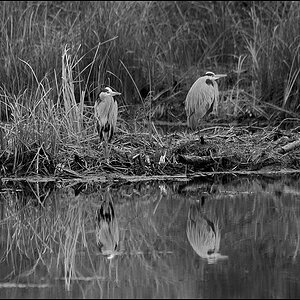
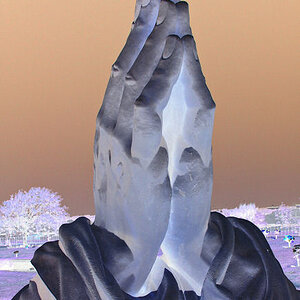
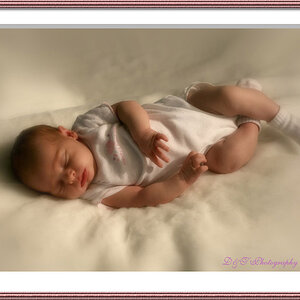
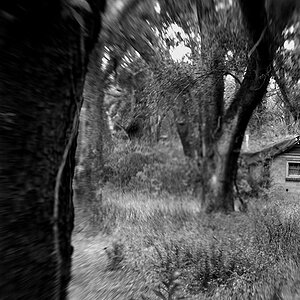
![[No title]](/data/xfmg/thumbnail/37/37134-5a2bb173004bc7a08fdf2124814ebdc1.jpg?1619737884)
